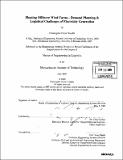Floating offshore wind farms : demand planning & logistical challenges of electricity generation
Author(s)
Nnadili, Christopher Dozie, 1978-
DownloadFull printable version (20.82Mb)
Other Contributors
Massachusetts Institute of Technology. Engineering Systems Division.
Advisor
Chris Caplice.
Terms of use
Metadata
Show full item recordAbstract
Floating offshore wind farms are likely to become the next paradigm in electricity generation from wind energy mainly because of the near constant high wind speeds in an offshore environment as opposed to the erratic wind speeds in their onshore counterparts. By using floaters adapted from oilrigs, floating offshore wind farms can be operated with larger wind turbines for increased power generation. In the United States, floating offshore wind farms located off the coast of New England would be near large load centers and accessible to transmission load lines with low capacity utilization. Apart from the technological challenges of building floating offshore wind farms stemming from the developmental stage of the floater technology, there are three major logistical challenges prospective operators would likely encounter in harvesting electricity. The first challenge is to understand the interaction between distances from shore to locate a wind farm given increasing wind speeds. The second challenge is to understand the marginal impact of distance from shore on revenue generated from electricity sales from a floating offshore wind farm. And finally the third challenge is to determine inventory policy for wind turbine components in operating a floating offshore wind farm given its more complex operation and maintenance schedule. To address these challenges, this study examines a hypothetical 100 units of 5MW wind turbines to understand the economics of locating a floating offshore wind farm. (cont.) It is important to know the intersection between the increase in revenue generated with distance from shore and increase in operation & maintenance costs of a floating offshore wind farm. Because there is currently no floating offshore wind farm at the time of this writing, estimated failure rate data was used to study demand patterns for offshore wind turbine components. Three of maintenance strategies were examined. The results obtained from this work will serve as a blue print for prospective operators of floating offshore wind farms in logistics planning and inventory management of wind turbine components for electricity generation.
Description
Thesis (M. Eng. in Logistics)--Massachusetts Institute of Technology, Engineering Systems Division, 2009. Includes bibliographical references (leaf 46).
Date issued
2009Department
Massachusetts Institute of Technology. Engineering Systems DivisionPublisher
Massachusetts Institute of Technology
Keywords
Engineering Systems Division.